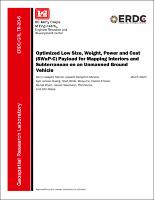Please use this identifier to cite or link to this item:
https://hdl.handle.net/11681/35878Full metadata record
| DC Field | Value | Language |
|---|---|---|
| dc.contributor.author | Glaspell, Garry P. | - |
| dc.contributor.author | Lessard, Steven R. | - |
| dc.contributor.author | Christie, Benjamin A. | - |
| dc.contributor.author | Jannak-Huang, Kyle | - |
| dc.contributor.author | Wilde, Noah C. | - |
| dc.contributor.author | He, Weiyu | - |
| dc.contributor.author | Ennasr, Osama. | - |
| dc.contributor.author | Pham, Daniel T. | - |
| dc.contributor.author | Hasemann, Daniel B. | - |
| dc.contributor.author | Devine, Philip M. | - |
| dc.contributor.author | Kiene, John | - |
| dc.date.accessioned | 2020-03-18T14:03:26Z | - |
| dc.date.available | 2020-03-18T14:03:26Z | - |
| dc.date.issued | 2020-03 | - |
| dc.identifier.govdoc | ERDC/GRL TR-20-6 | - |
| dc.identifier.uri | http://hdl.handle.net/11681/35878 | - |
| dc.identifier.uri | http://dx.doi.org/10.21079/11681/35878 | - |
| dc.description | Technical Report | - |
| dc.description.abstract | Section 3 of the FY15 Force 2025 Maneuvers Annual Report indicates that in Dense Urban Areas (DUA), specifically in a subsurface, surface, or super-surface structure, the ability to identify threats will be diminished. Most commercially available LIght Detection And Ranging (LIDAR) systems are specifically designed for high-resolution aerial imaging and mapping applications. As a result, they tend to be large, heavy, power-hungry, data bandwidth intensive, and expensive. They also employ lasers that are not typically eye-safe, which limits their overall effectiveness in subterranean and the interiors of subsurface or super-surface structures. However, due to recent advances in the automotive industry, there are new generations of Size, Weight, Power, and Cost (SWaP-C) sensors that are eye-safe, making them suitable for use indoors and in subterranean environments. While these tradeoffs limit their effective use to hundreds of meters (compared to kilometers for their more expensive counterparts), they are ideal candidates for use in subterranean and building interiors. While cameras fill this niche to some extent, the volumetric calculations provided by these sensors provide additional intelligence to shape the security of the environment and offer more precision when maneuvering troops. These sensors would provide the warfighter with situational understanding in previously inaccessible locations. Therefore, to aid in the Army’s need to obtain and maintain situational understanding in DUAs, the authors propose utilizing low size, weight, power, and cost (SWaP-C) sensors, on a robot platform, for surveying and mapping underground structures and building interiors. Rapid/near real-time data processing is possible by utilizing open-source software and commercial off the shelf (COTS) components. Using the preferred sensor payload autonomously was also explored. | en_US |
| dc.description.sponsorship | United States. Army. Corps of Engineers. | en_US |
| dc.description.tableofcontents | Abstract .......................................................................................................................................................... ii Figures ............................................................................................................................................................ iv Preface ............................................................................................................................................................. v 1 Introduction ............................................................................................................................................ 1 1.1 Background .................................................................................................................... 1 1.2 Objective ........................................................................................................................ 2 1.3 Approach ........................................................................................................................ 2 2 Sensors.................................................................................................................................................... 5 3 SLAM Modules ..................................................................................................................................... 14 4 Sensor Fusion ...................................................................................................................................... 23 5 Virtualization ........................................................................................................................................ 34 6 Wireless Ranging ................................................................................................................................ 38 7 Automation ........................................................................................................................................... 45 8 Future Advancements ........................................................................................................................ 57 9 Conclusion ............................................................................................................................................ 59 References ................................................................................................................................................... 61 Appendix A: Sensor List ............................................................................................................................. 63 Appendix B: Setup Procedure for Astra and D435 ............................................................................... 69 Appendix C: Installation of SLAM modules ........................................................................................... 75 Appendix D: RTABMAP Launch files .................................................................................................... 128 Appendix E: POZYX .................................................................................................................................. 163 Appendix F: Automation ......................................................................................................................... 197 Unit Conversion Factors ......................................................................................................................... 208 Acronyms ................................................................................................................................................... 209 Report Documentation Page | - |
| dc.format.extent | 218 pages / 10.25 Mb | - |
| dc.format.medium | - | |
| dc.language.iso | en_US | en_US |
| dc.publisher | Geospatial Research Laboratory (U.S.) | en_US |
| dc.publisher | Engineer Research and Development Center (U.S.) | - |
| dc.relation.ispartofseries | Technical Report (Engineer Research and Development Center (U.S.)) ; no. ERDC/GRL TR-20-6 | - |
| dc.rights | Approved for Public Release; Distribution is Unlimited | - |
| dc.source | This Digital Resource was created in Microsoft Word and Adobe Acrobat | - |
| dc.subject | Military surveillance | en_US |
| dc.subject | Detectors | en_US |
| dc.subject | Military robots | en_US |
| dc.subject | Cities and towns | en_US |
| dc.subject | Underground construction--Military surveillance | en_US |
| dc.subject | Buildings--Military surveillance | en_US |
| dc.title | Optimized low Size, Weight, Power and Cost (SWaP-C) payload for mapping interiors and subterranean on an Unmanned Ground Vehicle | en_US |
| dc.type | Report | en_US |
| Appears in Collections: | Technical Report | |
Files in This Item:
| File | Description | Size | Format | |
|---|---|---|---|---|
| ERDC-GRL TR-20-6.pdf | 10.25 MB | Adobe PDF |  View/Open |